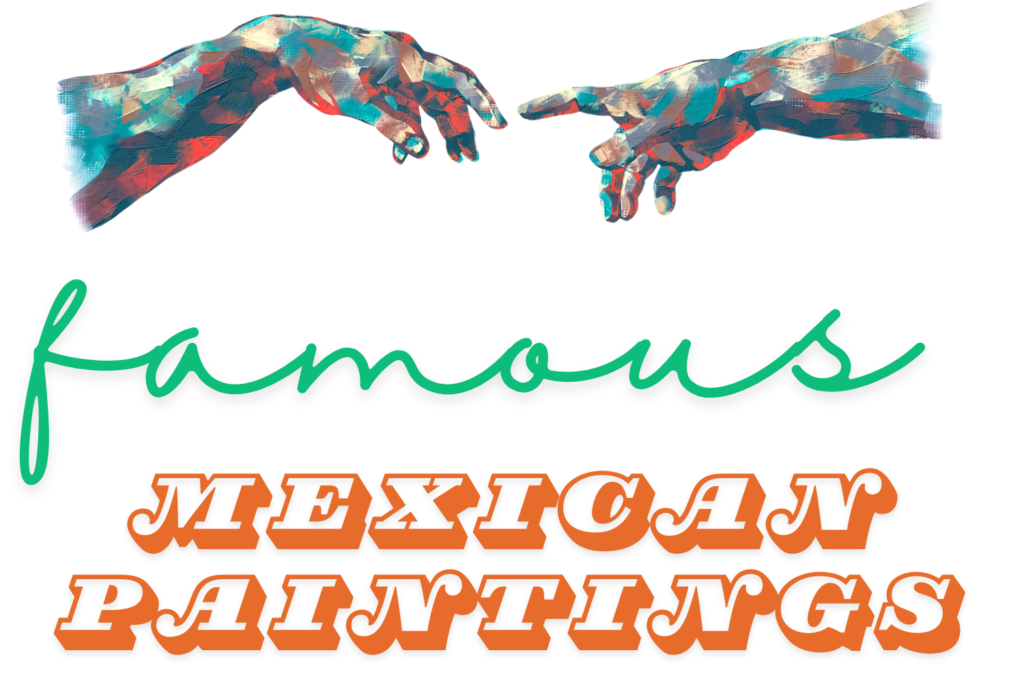Mexico boasts a rich cultural tapestry, woven with vibrant threads of history, tradition, and art. From the grandiose murals of Diego Rivera to the surrealist canvases of Frida Kahlo, Mexican art has left an indelible mark on the world. This blog post will explore some of the most famous Mexican paintings, delving into their historical context, artistic significance, and the stories they tell.
1. “The Two Fridas” by Frida Kahlo
Frida Kahlo, one of the most iconic figures in Mexican art, painted “The Two Fridas” in 1939. This double self-portrait depicts two versions of the artist sitting side by side, holding hands. One Frida is dressed in traditional Tehuana attire, representing her Mexican heritage, while the other wears a Victorian dress, symbolizing her European ancestry. The painting reflects Kahlo’s inner turmoil following her divorce from Diego Rivera, highlighting themes of identity, duality, and emotional pain. The exposed hearts and blood vessels in the painting underscore her physical and emotional suffering.
2. “Man at the Crossroads” by Diego Rivera
Diego Rivera, Kahlo’s husband and a prominent muralist, created “Man at the Crossroads” in 1933. Originally commissioned for the Rockefeller Center in New York City, the mural sparked controversy due to its inclusion of communist imagery, leading to its destruction. Rivera later recreated it in the Palace of Fine Arts in Mexico City, renaming it “Man, Controller of the Universe.” The mural portrays a central figure operating a machine, symbolizing humanity’s power over nature and technology. Surrounding this figure are scenes depicting scientific advancements, industrial progress, and political ideologies, illustrating the complex interplay of forces shaping the modern world.
3. “Echo of a Scream” by David Alfaro Siqueiros
David Alfaro Siqueiros, another leading figure in the Mexican muralist movement, painted “Echo of a Scream” in 1937. This powerful, haunting image portrays a child screaming amidst a desolate, war-torn landscape. The painting serves as a poignant commentary on the horrors of war, particularly the Spanish Civil War, which Siqueiros witnessed firsthand. The stark contrast between the child’s vulnerable, human figure and the mechanical, industrial debris highlights the dehumanizing effects of conflict and modernization.
4. “The Dream of a Sunday Afternoon in Alameda Central Park” by Diego Rivera
Diego Rivera’s mural “The Dream of a Sunday Afternoon in Alameda Central Park,” completed in 1947, is a vibrant tableau that captures 400 years of Mexican history. The mural features over 100 characters, including historical figures such as Hernán Cortés, Porfirio Díaz, and Benito Juárez, alongside everyday people from different eras. At the center, Rivera depicts himself as a child holding hands with La Catrina, a skeleton figure symbolizing death, and Frida Kahlo. This rich, detailed work serves as a historical narrative, reflecting Mexico’s complex past and cultural evolution.
5. “Our Lady of Guadalupe” by Marcos Cipac de Aquino
“Our Lady of Guadalupe,” painted by Marcos Cipac de Aquino in 1531, is one of Mexico’s most revered religious icons. According to legend, the Virgin Mary appeared to an indigenous man named Juan Diego and asked him to build a church in her honor. As proof of her apparition, she left an image of herself imprinted on his cloak. This painting, housed in the Basilica of Our Lady of Guadalupe in Mexico City, has become a symbol of Mexican identity and faith, blending indigenous and Spanish Catholic traditions.
6. “The Mole Poblano” by Francisco Toledo
Francisco Toledo, a contemporary artist from Oaxaca, created “The Mole Poblano” in 1992. This whimsical, colorful painting celebrates the traditional Mexican dish mole poblano, a rich, complex sauce made with chocolate and various spices. Toledo’s work often incorporates elements of Mexican folklore, mythology, and everyday life, blending surrealism and abstraction. “The Mole Poblano” reflects his deep connection to his cultural roots and his ability to transform ordinary subjects into extraordinary art.
7. “Zapata” by José Clemente Orozco
José Clemente Orozco, another key figure in the Mexican muralist movement, painted “Zapata” in 1930. This striking image of Emiliano Zapata, the revolutionary leader, depicts him as a powerful, heroic figure, embodying the spirit of the Mexican Revolution. Orozco’s use of bold lines, dramatic contrasts, and dynamic composition captures the intensity and passion of the revolutionary struggle. The painting is a testament to the enduring legacy of Zapata and the fight for social justice in Mexico.
8. “The Offering” by Saturnino Herrán
Saturnino Herrán, an early 20th-century painter, is known for his depictions of Mexican culture and indigenous people. “The Offering,” painted in 1913, is a poignant scene of a group of indigenous women making an offering to the gods. The painting’s rich colors, meticulous details, and solemn atmosphere convey a deep sense of spirituality and reverence. Herrán’s work is celebrated for its ability to capture the beauty and dignity of Mexico’s indigenous heritage.
9. “The Great City of Tenochtitlan” by Diego Rivera
Diego Rivera’s mural “The Great City of Tenochtitlan,” completed in 1945, is part of his series of murals in the National Palace in Mexico City. The mural depicts the bustling, vibrant capital of the Aztec Empire at its height, with scenes of everyday life, trade, and cultural practices. Rivera’s meticulous attention to detail and vivid colors bring the ancient city to life, offering a glimpse into pre-Columbian Mexico and its rich cultural heritage.
10. “The Virgin of Guadalupe” by José María Velasco
José María Velasco, a renowned 19th-century landscape painter, created “The Virgin of Guadalupe” in 1882. This painting combines a serene, picturesque landscape with the image of the Virgin Mary appearing to Juan Diego. Velasco’s work is celebrated for its exquisite detail, masterful use of light and shadow, and deep sense of tranquility. The painting reflects the artist’s reverence for Mexico’s natural beauty and spiritual traditions.
Conclusion:
The masterpieces of Mexican art offer a window into the country’s soul, revealing its history, culture, and enduring spirit. From the poignant self-portraits of Frida Kahlo to the grand murals of Diego Rivera, these paintings capture the essence of Mexico in all its complexity and beauty. They remind us of the power of art to transcend time and space, connecting us to the past and inspiring us for the future. As we journey through these famous Mexican paintings, we celebrate the creativity, resilience, and vibrant heritage of a nation that continues to enchant and inspire the world.
FAQs:
1. What are some of the most famous Mexican paintings?
Some of the most famous Mexican paintings include “The Two Fridas” by Frida Kahlo, “Man at the Crossroads” by Diego Rivera, “Echo of a Scream” by David Alfaro Siqueiros, “The Dream of a Sunday Afternoon in Alameda Central Park” by Diego Rivera, and “Zapata” by José Clemente Orozco. These works are celebrated for their artistic excellence and cultural significance.
2. Who are the most renowned Mexican artists?
The most renowned Mexican artists include Frida Kahlo, Diego Rivera, David Alfaro Siqueiros, and José Clemente Orozco. These artists are known for their significant contributions to the Mexican muralist movement and their powerful portrayals of Mexican culture, history, and social issues.
3. What is the significance of Frida Kahlo’s “The Two Fridas”?
“The Two Fridas” is significant for its exploration of identity, duality, and emotional pain. Painted in 1939 after her divorce from Diego Rivera, the double self-portrait reflects Kahlo’s inner turmoil and her struggle with her mixed heritage. The painting is a poignant expression of her personal suffering and resilience.
4. What themes are commonly found in Mexican murals?
Mexican murals often explore themes such as social justice, political struggle, cultural identity, and historical narratives. Artists like Diego Rivera, David Alfaro Siqueiros, and José Clemente Orozco used their murals to depict the lives of ordinary people, historical events, and revolutionary ideals, aiming to educate and inspire the public.
5. Where can one view these famous Mexican paintings?
Many famous Mexican paintings and murals can be viewed in prominent museums and public spaces in Mexico. For example, Diego Rivera’s murals can be found in the National Palace and the Palace of Fine Arts in Mexico City. Frida Kahlo’s works are displayed in the Frida Kahlo Museum (La Casa Azul) in Coyoacán, Mexico City. Additionally, major art institutions around the world often feature exhibitions of Mexican art.

